The Future of Fashion is Digital.
What is the future of Fashion? Especially as it pertains to the role and skills of the designer. To get a bit of perspective we asked the designers of the future to share their thoughts on the subject.
Can you tell us a little about yourselves?
Generative Rendered Design (GRD) are Students in the Fashion & Technology and Time-based Media Departments at University of Arts and Industrial Design Linz/Austria. We are working together as a collective, where everybody involved provides skills and knowledge in different areas to the process.
What’s the problem facing fashion designers?
In our opinion the most important thing that needs changing is the mindset of the new generation of designers. Fashion design today is a slow, manual process that doesn't match the needs or methods of creative types. And sewing and assembly will also not be able to continue the way that it used to. Digitization will get rid of a lot of the old steps we use.
For example, at the moment we are creating prototypes and almost everything is done by hand. That’s a real problem. It’s just too slow and there is too much chance for errors and rework. That’s why one of our other focuses is to use industrial machines for rapid prototyping and production. We also believe that the automated manufacturing trend will lead to companies producing clothes locally and moving assembly jobs back to western countries again.
What's your vision for the future?
Our vision is simple and elegant. Create a cross-disciplinary design and manufacturing strategy which focuses on digital design, digital media and digital fabrication tools. We believe this type of environmental shift allows us to think about fashion in a new way and increases our ability to create, present, and produce garments. So young designers need to be aware of the fact that changes in the tools and manufacturing will lead to new ways of designing, showing and producing clothes.
What was the major reason you decided you needed to transition to digital?
We have been working with 3D design data for a while now and it's really opened up our thinking and given us more options when trying to validate concepts. Now that we're comfortable with that part of the process we have been searching for a digital solution for our 2D patterning and production methods. The change also is important because we need to find a more sustainable way to create, show, and then produce clothes. The old process takes months, and it is wasteful and expensive.
Why did you select your current 3D CAD solution?
Right now, we are using Rhino 3D for design and Blender for rendering. We don’t really have a strategic reason other than the fact that we had easy access to the software and training documentation. There are so many different design products out there which might be better or more efficient, but in the end, we decided that we needed to pick one to master and just get started. All of the professional design products are very complicated and it takes a lot of knowledge to master even one part of the tool. It's a barrier that we hope will get easier in the future.
What helped you to determine that ExactFlat Digital Patterning would work?
New technologies like 3D Bonding and Automated Sewing will change the way garments and accessories are produced. Click on the image to learn more.
We've had our eyes on ExactFlat for quite some time now. It seemed that the results are the best in terms of flattening processes. Nothing else we tried appeared to create patterns that fit. And it works with Rhino 3D and Blender so that was a bonus. We're just starting to use the tools in actual production now but so far everything looks really good.
What is the one thing you like the most about your new process?
It is really two things. We have much more design freedom and the pattern making software is really easy to use. All we do is open the part, set up the cut lines, flatten and optimize the pattern. From there we take the output and print, cut and sew. It really saves a lot of time.
What’s next?
We are working on a couple projects to validate the complete workflow. We are also inviting others to join us on the journey to the future of fashion. We think we have the right model. Now all we need to do is prove to ourselves and the industry.












